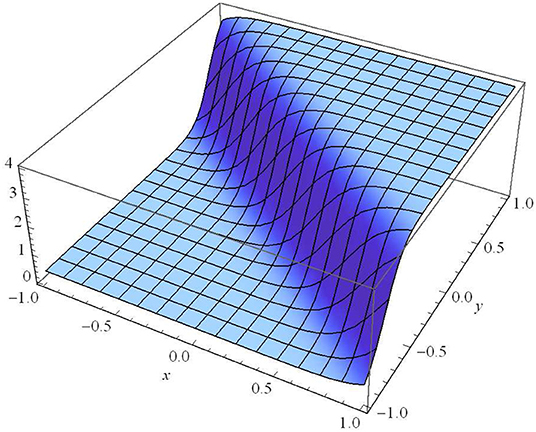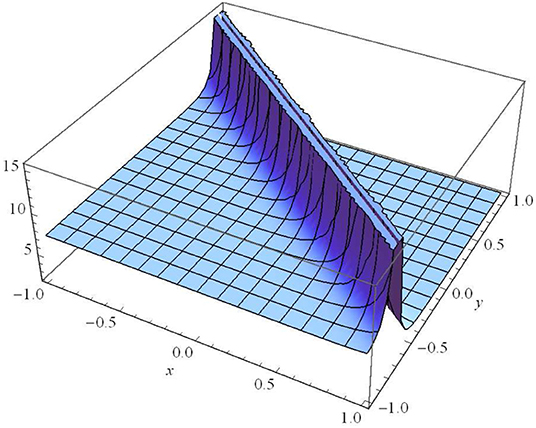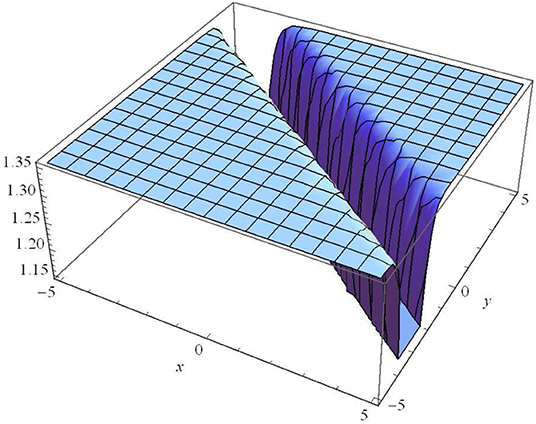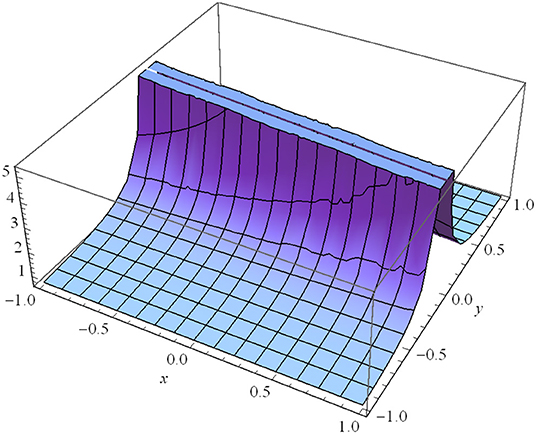
94% of researchers rate our articles as excellent or good
Learn more about the work of our research integrity team to safeguard the quality of each article we publish.
Find out more
ORIGINAL RESEARCH article
Front. Phys., 07 July 2020
Sec. Statistical and Computational Physics
Volume 8 - 2020 | https://doi.org/10.3389/fphy.2020.00215
This article is part of the Research TopicComplex Dynamical Systems with Analytical and Numerical Wave SolutionsView all 6 articles
 M. S. Osman1,2*
M. S. Osman1,2* Dumitru Baleanu3,4,5*
Dumitru Baleanu3,4,5* Kalim Ul-Haq Tariq6
Kalim Ul-Haq Tariq6 Melike Kaplan7
Melike Kaplan7 Muhammad Younis8
Muhammad Younis8 Syed Tahir Raza Rizvi9
Syed Tahir Raza Rizvi9A versatile integration tool, namely the protracted (or extended) Fan sub-equation (PFS-E) technique, is devoted to retrieving a variety of solutions for different models in many fields of the sciences. This essay presents the dynamics of progressive wave solutions via the 2D-chiral nonlinear Schrödinger (2D-CNLS) equation. The solutions acquired comprise dark optical solitons, periodic solitons, singular dark (bright) solitons, and singular periodic solutions. By comparing the results gained in this work with other literature, it can be noticed that the PFS-E method is an useful technique for finding solutions to other similar problems. Furthermore, some new types of solutions are revealed that will help us better understand the dynamic behaviors of the 2D-CNLS model.
The attainment of analytical solutions for different models described by NLPDEs plays a major role in applied mathematics, fluid mechanics, fluid dynamics, plasma and solid-state physics, nonlinear optics, and chemistry. Among these solutions, the optical solitons, which have significant applications in modern communication systems, and have attracted particular attention from physicists as well as mathematicians [1–5]. Optical solitons can propagate over extremely large distances without shape change when a balance between the linear dispersion and nonlinear effects is achieved. There are many types of solitons, including bright, dark, anti-dark, and singular solitons, amongst many others. Bright solitons exist on a zero-intensity background, while dark solitons arise as an intensity dip in an infinitely extended constant background. Moreover, dark solitons are less influenced by the perturbations, which means that dark solitons could be more preferable than bright ones in optical communication systems. The anti-dark solitons have profiles similar to those of the bright ones but exist on a nonzero background like the dark ones [6, 7]. Many effective methods have been presented to solve these equations [8–26].
The PFS-E method [27, 28] is a direct and concise method to solve nonlinear evolution equations. It is employed to find and study the wave solutions of the 2D-CNLS equation. The predominating equation is described by [29–32]:
where Φ = Φ(x, y, t) refers to the complex-valued function, μ1 is the second-order dispersion coefficient, and μ2, μ3 are the self-steepening coefficients. The 2D-CNLS equation has been established by a one-dimensional reduction of the structure that defines the fractional quantum Hall effect (it is a quantum-mechanical version of the Hall effect existing in 2D electron systems related to strong magnetic fields and low temperatures). An extraordinary characteristic of Equation (1) is the nonlinearity of the current density, which informs the new execution for the SPM and self-focusing through the current [29–32]. This equation cannot pass the Painlevè test of integrability and is not invariant under the Galilean transformation [32].
Bulut et al. [30] discussed Equation (1) in 1D and 2D and found bright and dark soliton solutions via the extended sinh-Gordon equation method. Nishino et al. [33] solved Equation (1) in 1D only and introduced two categories of wave solutions like bright and dark soliton trains. Very recently, Raza and Javid [32] investigated the singular and dark solitons for the 2D-CNLS equation by two different approaches, namely the extended direct algebraic and trial equation methods. To the best of our knowledge, no studies have found optical wave solutions for (1) via the extended Fan sub-equation method.
The paper is organized as follows. Different solutions for the 2D-CNLS equation are evaluated in section 2. The physical interpretation of the solutions is discussed in section 3. The main deductions are presented in section 4.
In this section, we use the PFS-E technique to find more forms of exact solutions for Equation (1) by considering a more general transformation stated in [34, 35]. The PFS-E method includes an algebraic strategy to find different analytical solutions for NLPDEs that can be expressed as a polynomial in the variable that satisfies the general Riccati equation. The most significant achievement of this approach is that it offers all the solutions that can be found by the use of other methods such as processes using the Riccati equation, an elliptic equation of the first kind, an auxiliary ordinary equation, or the generalized Riccati equation as mapping equation.
Let the wave profile be defined as
while the amplitude
and
Inserting (2) into (1) and separating its real and imaginary parts, we get
where
and
From (7), we have
From the homogeneous balance condition on (5), the general solution can be written as
where ϕ is given by the following auxiliary equation,
where ζi(i = 0, 1, 2, 3, 4) are free parameters.
Plugging (9) and (10) into (5) and setting the coefficients of ϕj, j = 0, 1, ⋯ , 4 identical zero, we get
Here, suitable values are selected for ζi, (i = 0, 1, 2, 3, 4).
which give
Different cases [34, 35] can be introduced to obtain the following solutions.
Case I.
If , we get the solution of (1) in the form A variety of significant solitons are obtained below.
Type I: when , ϑ1ϑ2 ≠ 0, ϑ2ϑ3 ≠ 0. A set of dark optical solitons is acquired as
A variety of bright-dark optical soliton is gained as
A set of singular dark optical solitons is obtained as
The family of solitons is obtained as
Type II: when , ϑ1ϑ2 ≠ 0, ϑ2ϑ3 ≠ 0. The following collections of periodic solitons are given by
Case II.
If , we get the solution of (1) in the form A collection of dark optical solitons is given by
Also, a different shape of singular dark optical soliton is acquired
Case III.
If ζ0 = ζ1 = 0, we get the solution of (1) in the form .
Type I: , where λ1, λ2, λ3 are arbitrary constants.
Type II: , where λ1, λ2, λ3 are arbitrary constants.
In particular, if we take λ2 = 0 in the above Equations (23), (24), we get
Type III: , where λ1, λ2, λ3, λ4 are arbitrary constants.
Type IV: , where λ1, λ2, λ3, λ4 are arbitrary constants.
In particular, if we consider λ2 = λ4, we have another solution as
Type V: , where λ1, λ2, λ3 are arbitrary constants.
Type VI: , where λ1, λ2, λ3 are arbitrary constants.
Type VII: , where λ1, λ2, λ3, λ4 are arbitrary constants.
Case IV.
If ζ1 = ζ3 = 0, we get the solution of (1) in the form .
For , the solution of (1) of the form
leads to the bright optical soliton when m → 1,
and the singular periodic solutions when m → 0,
For , the solution of (1) of the form
leads to a collection of singular dark solutions when m → 1,
and singular periodic solutions when m → 0,
In this part, the physical aspects of the solutions obtained are discussed by means of graphical 3D representations. Figures 1–4 show different categories of background for soliton solutions classified into dark or singular soliton solutions.

Figure 1. ϑ1=1, ϑ2 = −1, ϑ3 = 1, μ1 = 1, μ2 = 1, μ3 = 1, α0 = 1, β0 = 2, λ0 = 3, α1 = 4, β1 = 5, λ = 6, η0 = 1, t = 0.01.
Figure 1 illustrates established in Case I (Type I) for ϑ1 = 1, ϑ2 = −1, ϑ3 = 1, μ1 = 1, μ2 = 1, μ3 = 1, α0 = 1, β0 = 2, λ0 = 3, α1 = 4, β1 = 5, λ = 6, η0 = 1, t = 0.01.
Moreover, Figure 2 illustrates found in Case II for ϑ1 = 1, ϑ2 = −1, ϑ3 = 1, μ1 = 1, μ2 = 1, μ3 = 1, α0 = 1, β0 = 2, λ0 = 3, α1 = 4, β1 = 5, λ = 6, η0 = 1, t = 0.1.

Figure 2. ϑ1=1, ϑ2 = −1, ϑ3 = 1, μ1 = 1, μ2 = 1, μ3 = 1, α0 = 1, β0 = 2, λ0 = 3, α1 = 4, β1 = 5, λ = 6, η0 = 1, t = 0.1.
Similarly, Figure 3 illustrates found in Case III (Type I) for λ1 = 1, λ2 = 2, λ3 = 3, μ1 = 1, μ2 = 1, μ3 = 1, α0 = 1, β0 = 2, λ0 = 3, α1 = 4, β1 = 5, λ = 6, η0 = 1, t = 1. Similarly, Figure 4 expresses observed in Case IV (m → 1) for μ1=1, μ2=1, μ3 = 2, α0 = 1, β0 = 2, λ0 = 3, α1 = 0.1, β1 = 1, λ = 0.5, η0 = 1, t = 0.1.

Figure 3. λ1 = 1, λ2 = 2, λ3 = 3, μ1 = 1, μ2 = 1, μ3 = 1, α0 = 1, β0 = 2, λ0 = 3, α1 = 4, β1=5, λ = 6, η0 = 1, t = 1.

Figure 4. for m → 1: μ1 = 1, μ2 = 1, μ3 = 2, α0 = 1, β0 = 2, λ0 = 3, α1 = 0.1, β1 = 1, λ = 0.5, η0 = 1, t = 0.1.
Figure 1 represents the absolute value of the complex wave solution given by Equation (14). We observe that this solution is a dark (or kink) soliton wave propagating along the y-axis. The kink wave is an essential aspect of numerous physical phenomena containing self-reinforcing, impulsive systems, and reaction-diffusion-advection. It is clear that there is a transmission of the dark soliton with invariant amplitude (without any gain or loss) in the homogeneous medium of motion. Due to the homogeneous (constant) coefficients of Equation (1), we cannot provide a possible way to control the propagation of the dark solitons in this medium. Figures 2–4 represent the absolute value of the complex wave solutions given by Equations (22), (23), and (37), respectively. We observe that these solutions are singular solitons that can be linked to a solitary wave when its center becomes an imaginary position. Furthermore, It is clear that their intensity gets Stronger, and consequently, they are not stable. These solutions have a cusp, which may lead to the formation of Rogue waves.
Herein, a large set of new analytical solutions with different wave structures of the 2D-CNLS equation has been reproduced with the aid of the PFS-E technique. As a positive result, a wide variety of unprecedented exact solutions were gained in an easy manner. Our study presents whether the suggested approach is trustworthy in treatment NLPDEs to promote a variety of exact solutions. Finally, we have plotted some 3D graphs of these solutions and have shown that these graphs can be controlled by adjusting the parameters. According to our knowledge, the obtained solutions are likely to provide a useful supplement to the existing literature on nonlinear optics.
All authors listed have made a substantial, direct and intellectual contribution to the work, and approved it for publication.
The authors declare that the research was conducted in the absence of any commercial or financial relationships that could be construed as a potential conflict of interest.
1. Biswas A, Konar S. Introduction to Non-Kerr Law Optical Solitons. Chapman and Hall; CRC Press (2006).
2. Zhou Q, Mirzazadeh M, Ekici M, Sonmezoglu A. Analytical study of solitons in non-Kerr nonlinear negative-index materials. Nonlinear Dyn. (2016) 86:623–38. doi: 10.1007/s11071-016-2911-1
3. Ding Y, Osman MS, Wazwaz AM. Abundant complex wave solutions for the nonautonomous Fokas-Lenells equation in presence of perturbation terms. Optik. (2019) 181:503–13. doi: 10.1016/j.ijleo.2018.12.064
4. Liu JG, Osman MS, Wazwaz AM. A variety of nonautonomous complex wave solutions for the (2+ 1)-dimensional nonlinear Schrödinger equation with variable coefficients in nonlinear optical fibers. Optik. (2019) 180:917–23. doi: 10.1016/j.ijleo.2018.12.002
5. Osman MS. New analytical study of water waves described by coupled fractional variant Boussinesq equation in fluid dynamics. Pramana. (2019) 93:26. doi: 10.1007/s12043-019-1785-4
6. Foursa D, Emplit P. Experimental investigation of dark soliton amplification in an optical fibre by stimulated Raman scattering. Electron Lett. (1996) 32:919–21. doi: 10.1049/el:19960614
7. Kivshar YS. Nonlinear dynamics near the zero-dispersion point in optical fibers. Phys Rev A. (1991) 43:1677. doi: 10.1103/PhysRevA.43.1677
8. Osman MS, Baleanu D, Adem AR, Hosseini K, Mirzazadeh M, Eslami M. Double-wave solutions and Lie symmetry analysis to the (2+ 1)-dimensional coupled Burgers equations. Chin J Phys. (2020) 63:122–9. doi: 10.1016/j.cjph.2019.11.005
9. Osman MS, Liu JG, Hosseini K, Yusuf A. Different wave structures and stability analysis for the generalized (2+ 1)-dimensional Camassa-Holm-Kadomtsev-Petviashvili equation. Phys Scr. (2019) 95:035229. doi: 10.1088/1402-4896/ab52c1
10. Lu D, Osman MS, Khater MMA, Attia RAM, Baleanu D. Analytical and numerical simulations for the kinetics of phase separation in iron [FeCrX (X = Mo, Cu)] based on ternary alloys. Phys A. (2020) 537:122634. doi: 10.1016/j.physa.2019.122634
11. Lu D, Tariq KU, Osman MS, Baleanu D, Younis M, Khater MMA. New analytical wave structures for the (3+ 1)-dimensional Kadomtsev-Petviashvili and the generalized Boussinesq models and their applications. Results Phys. (2019) 14:102491. doi: 10.1016/j.rinp.2019.102491
12. Hirota R. Exact solution of the Kortewegde Vries equation for multiple collisions of solitons. Phys Rev Lett. (1971) 27:1192. doi: 10.1103/PhysRevLett.27.1192
13. Roy R, Akbar MA, Wazwaz AM. Exact wave solutions for the nonlinear time fractional Sharma-Tasso-Olver equation and the fractional Klein-Gordon equation in mathematical physics. Opt Quant Electron. (2018) 50:25. doi: 10.1007/s11082-017-1296-9
14. Osman MS. One-soliton shaping and inelastic collision between double solitons in the fifth-order variable-coefficient Sawada-Kotera equation. Nonlinear Dyn. (2019) 96:1491–6. doi: 10.1007/s11071-019-04866-1
15. Javid A, Raza N, Osman MS. Multi-solitons of thermophoretic motion equation depicting the wrinkle propagation in substrate-supported graphene sheets. Commun Theor Phys. (2019) 71:362. doi: 10.1088/0253-6102/71/4/362
16. Osman MS, Ghanbari B, Machado JAT. New complex waves in nonlinear optics based on the complex Ginzburg-Landau equation with Kerr law nonlinearity. Eur Phys J Plus. (2019) 134:20. doi: 10.1140/epjp/i2019-12442-4
17. Kumar D, Kaplan M. Application of the modified Kudryashov method to the generalized Schrödinger-Boussinesq equations. Opt Quant Electron. (2018) 50:329. doi: 10.1007/s11082-018-1595-9
18. Osman MS, Lu D, Khater MM. A study of optical wave propagation in the nonautonomous Schrödinger-Hirota equation with power-law nonlinearity. Results Phys. (2019) 13:102157. doi: 10.1016/j.rinp.2019.102157
19. Kaplan M. Two different systematic techniques to find analytical solutions of the (2+ 1)-dimensional Boiti-Leon-Manna-Pempinelli equation. Chinese J Phys. (2018) 56:2523–30. doi: 10.1016/j.cjph.2018.06.005
20. Osman MS, Ghanbari B. New optical solitary wave solutions of Fokas-Lenells equation in presence of perturbation terms by a novel approach. Optik. (2018) 175:328–33. doi: 10.1016/j.ijleo.2018.08.007
21. Osman MS, Machado JAT. The dynamical behavior of mixed-type soliton solutions described by (2+ 1)-dimensional Bogoyavlensky-Konopelchenko equation with variable coefficients. J Electromagnet Wave. (2018) 32:1457–64. doi: 10.1080/09205071.2018.1445039
22. Rezazadeh H, Osman MS, Eslami M, Mirzazadeh M, Zhou Q, Badri SA, et al. Hyperbolic rational solutions to a variety of conformable fractional Boussinesq-Like equations. Nonlinear Eng. (2019) 8:224–30. doi: 10.1515/nleng-2018-0033
23. Osman MS. Multi-soliton rational solutions for quantum Zakharov-Kuznetsov equation in quantum magnetoplasmas. Waves Random Complex. (2016) 26:434–43. doi: 10.1080/17455030.2016.1166288
24. Raza N, Zubair A. Bright, dark and dark-singular soliton solutions of nonlinear Schrödinger's equation with spatio-temporal dispersion. J Mod Opt. (2018) 65:1975–82. doi: 10.1080/09500340.2018.1480066
25. Osman MS. Multi-soliton rational solutions for some nonlinear evolution equations. Open Phys. (2016) 14:26–36. doi: 10.1515/phys-2015-0056
26. Osman MS, Rezazadeh H, Eslami M, Neirameh A, Mirzazadeh M. Analytical study of solitons to benjamin-bona-mahony-peregrine equation with power law nonlinearity by using three methods. Univ Politeh Buch Ser A. (2018) 80:267–78. Available online at: https://www.scientificbulletin.upb.ro/rev_docs_arhiva/fullf37_570579.pdf
27. Zhang S, Xia T. A further improved extended Fan sub-equation method and its application to the (3+ 1)-dimensional Kadomstev-Petviashvili equation. Phys Lett A. (2006) 356:119–23. doi: 10.1016/j.physleta.2006.03.027
28. Cheemaa N, Younis M. New and more general traveling wave solutions for nonlinear Schrödinger equation. Waves Random Complex. (2016) 26:30–41. doi: 10.1080/17455030.2015.1099761
29. Eslami M. Trial solution technique to chiral nonlinear Schrodinger's equation in (1 + 2)-dimensions. Nonlinear Dyn. (2016) 85:813–6. doi: 10.1007/s11071-016-2724-2
30. Bulut H, Sulaiman TA, Demirdag B. Dynamics of soliton solutions in the chiral nonlinear Schrödinger equations. Nonlinear Dyn. (2018) 91:1985–91. doi: 10.1007/s11071-017-3997-9
31. Vyas VM, Patel P, Panigrahi PK, Kumar CN, Greiner W. Chirped chiral solitons in the nonlinear Schrödinger equation with self-steepening and self-frequency shift. Phys Rev A. (2008) 78:021803. doi: 10.1103/PhysRevA.78.021803
32. Raza N, Javid A. Optical dark and dark-singular soliton solutions of (1+ 2)-dimensional chiral nonlinear Schrodinger's equation. Waves Random Complex. (2019) 29:496–508. doi: 10.1080/17455030.2018.1451009
33. Nishino A, Umeno Y, Wadati M. Chiral nonlinear Schrödinger equation. Chaos Soliton Fract. (1998) 9:1063–9. doi: 10.1016/S0960-0779(97)00184-7
34. Yomba E. The extended fan sub-equation method and its application to the (2+1)-dimensional dispersive long wave and whitham-Broer-Kaup equations. Chinese J Phys. (2005) 43:789–805. Available online at: http://citeseerx.ist.psu.edu/viewdoc/download?doi=10.1.1.178.5618&rep=rep1&type=pdf
Keywords: 2D-CNLS equation, PFS-E algorithm, solitons, analytical solutions, waves structures
Citation: Osman MS, Baleanu D, Tariq KU-H, Kaplan M, Younis M and Rizvi STR (2020) Different Types of Progressive Wave Solutions via the 2D-Chiral Nonlinear Schrödinger Equation. Front. Phys. 8:215. doi: 10.3389/fphy.2020.00215
Received: 14 December 2019; Accepted: 20 May 2020;
Published: 07 July 2020.
Edited by:
Grienggrai Rajchakit, Maejo University, ThailandReviewed by:
Prasanta Panigrahi, Indian Institute of Science Education and Research Kolkata, IndiaCopyright © 2020 Osman, Baleanu, Tariq, Kaplan, Younis and Rizvi. This is an open-access article distributed under the terms of the Creative Commons Attribution License (CC BY). The use, distribution or reproduction in other forums is permitted, provided the original author(s) and the copyright owner(s) are credited and that the original publication in this journal is cited, in accordance with accepted academic practice. No use, distribution or reproduction is permitted which does not comply with these terms.
*Correspondence: M. S. Osman, bW9mYXR6aUBzY2kuY3UuZWR1LmVn; Dumitru Baleanu, ZHVtaXRydUBjYW5rYXlhLmVkdS50cg==
Disclaimer: All claims expressed in this article are solely those of the authors and do not necessarily represent those of their affiliated organizations, or those of the publisher, the editors and the reviewers. Any product that may be evaluated in this article or claim that may be made by its manufacturer is not guaranteed or endorsed by the publisher.
Research integrity at Frontiers

Learn more about the work of our research integrity team to safeguard the quality of each article we publish.